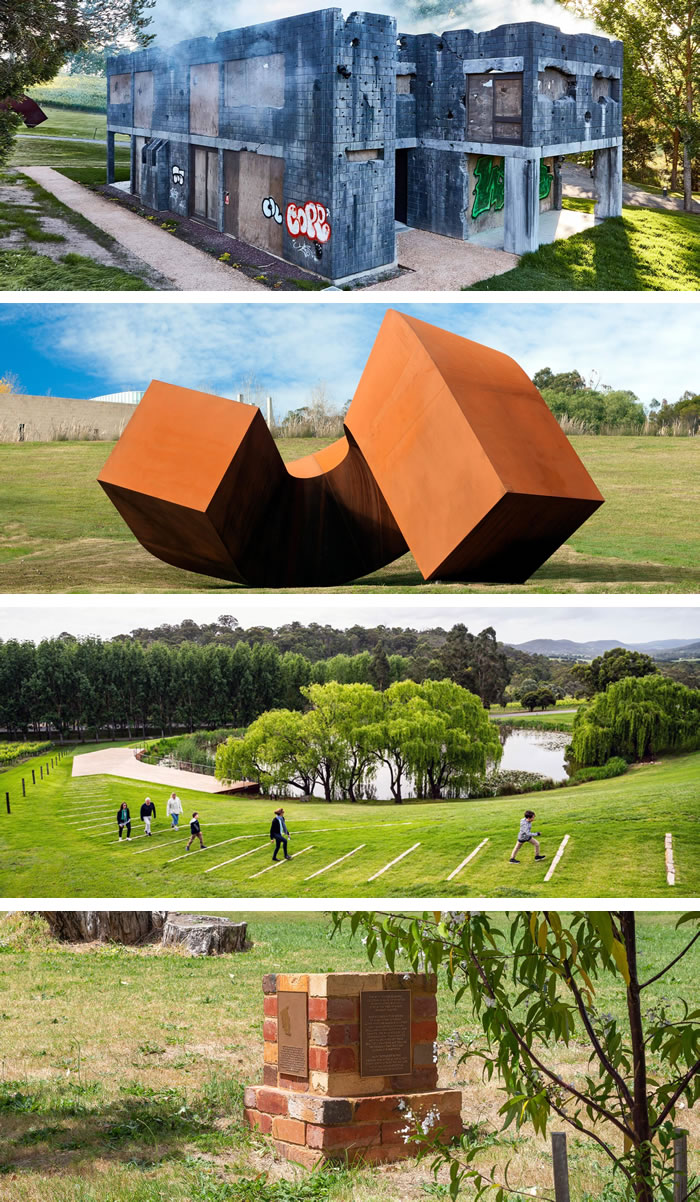TarraWarra Museum of Art | Grounds and Surrounds

Art exhibits in the Grounds and Surrounds of TarraWarra Museum of Art.
Valhalla
Originally created for the 52nd Venice Biennale (La Biennale di Venezia) in 2007, Callum Morton's awe-inspiring installation Valhalla was acquired for the TarraWarra Museum of Art collection in 2016.
Conceived in the wake of the destructive conflict in Afghanistan and prompted by the artist's discovery that his childhood home, designed by his architect father, had been pulled down by its new owners, Valhalla is a three-quarter scale remake of the original residence in ruin.
While the exterior surface of Morton's Valhalla is charred and crumbled as a result of some terrifying incident, the interior is a pristine corporate foyer, an antechamber for the visitor. By pushing the lift button, the lobby is transformed into a darkened space haunted by anxious sounds that nevertheless tilt towards a macabre humour. Valhalla becomes a state of mind-an anxiety about the destruction of life, and the loss of a sense of place. A further expression of the work is activated intermittently, usually at dusk, when smoke and lights appear to escape through the crevices of the ruined façade.
Awakening
A highlight of the Museum's collection, Clement Meadmore's lyrical outdoor sculpture Awakening, 1968, was originally commissioned for the AMP/St James plaza at the corner of Bourke Street and William Street in Melbourne. When the plaza was redeveloped in 2013, the sculpture was relocated to TarraWarra Museum of Art where it remains today as a permanent installation, sitting harmoniously within its new environment.
Made of Cor-ten steel, the work weighs over six tonnes and measures more than four metres in height and almost eight metres in length. Over time, this material develops a dark rust patina, which protects it from erosion. Meadmore was one of the first sculptors to work with Cor-ten steel, using it to create works which fuse elements of Abstract Expressionism and Minimalism into twisting, serpentine forms which, despite their immense weight, convey an impression of effortless physical grace.
The Grounds and Pathway
Designed by the Australian architect Allan Powell, TarraWarra Museum of Art is situated at the apex of a hill, offering a spectacular, resonant and panoramic experience of the Yarra Valley-Wurundjeri Country-with spectacular views of the surrounding mountain ranges and distant Toolangi rainforest across planted vines, native bushland and farmland.
With its lush lawns and avenue planting, visitors can experience the landscape setting, seasonal displays of the natural surrounds, and the Museum's outdoor sculptures, by taking a meandering pathway that winds around the Museum grounds.
A circular walking path, designed by Kate Seddon Landscape Design, begins with a welcome area near the lower carpark, before heading up past Callum Morton's Valhalla, and across the entry road with Jeffrey Smart-inspired arrows that continue as arrow-shaped steps up the hill. An unmarked walk takes visitors alongside the rammed earth façade of the Museum, and then back down the hill again past the vines, pausing at a lakeside deck, before turning in a serpentine form which reflects the curves of Clement Meadmore's Awakening, and returning to the lower carpark.
Kate Seddon's pathway nestles into the subtle and ever-changing natural terrain, sitting lightly on and in respect of this ancient land.
untitled (seven monuments)
untitled (seven monuments) is an art project by Aunty Joy Murphy Wandin (Wurundjeri), Jonathan Jones (Wiradjuri/Kamilaroi) and Tom Nicholson (Celtic-Australian). Seven monuments mark the historical boundary of Coranderrk Aboriginal Station, one of Australia's most significant sites.
Established by Wurundjeri people and other displaced Aboriginal people in 1863, Coranderrk Aboriginal Station quickly becomes both a thriving economic community and a powerful base for Aboriginal self-organisation and political advocacy. Coranderrk is reduced and undermined by the Victorian Colonial Government, ultimately leading to the dispersal and forced removal of the community to Lake Tyers in 1924, leaving only a handful of determined elders. Today Coranderrk continues to be an important living place for Wurundjeri and for the wider Aboriginal community.
untitled (seven monuments) invites you to move between seven sites that together mark the boundaries of Coranderrk at its largest, in 1866 when it was some 4,850 acres. Several sites are located within what is known today as Healesville. Others are outside the town.
Please note Valhalla may be closed during inclement weather.
❊ When ❊
Happens: Monday, Tuesday, Wednesday, Thursday, Friday, Saturday, Sunday
Times: 11:00am - 6:00pm
❊ Where ❊
TarraWarra Museum of Art View Venue
313 Healesville-Yarra Glen Road Healesville Victoria 3777 Map
℅ Woo-rite
✆ Venue: 1800 679 278 | +61 3 5962 3311 | Event: 03 5957 3100
✆ Venue: 1800 679 278 | +61 3 5962 3311 | Event: 03 5957 3100
❊ Web Links ❊
→ TarraWarra Museum of Art | Grounds and Surrounds→ www.twma.com.au
Disclaimer: Check with the venue (web links) before making plans, travelling or buying tickets.
Accessibility: Contact the venue for accessibility information.
Trending HOT
Beauty and the Beast | The MusicalIt's time to Be Our Guest! Disney's enchanting new musical, Beauty and the Beast, is now playing at Melbourne's Her Majesty's Theatre. This timeless tale has been ..
Things to see, hear & do this weekend
Make the most of your weekend in Melbourne with these fabulous events. No city does it better than Melbourne, so get out and discover the very best shows, festivals, ..
Update Page Upgrade Page










